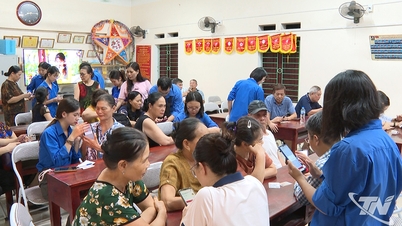
Provincial leaders make cashless payments on Hue-S app at Dong Ba market
Develop a specific action plan to develop and promote the use of digital platforms in the province; upgrade the Hue-S platform towards providing comprehensive digital services of state agencies for businesses and people. Digital data, including developing and implementing plans for data development and data human resource development in key areas: agriculture , health, education and training, natural resources and environment, transportation, labor, culture, sports and tourism in the province. Ensure that data is created in a machine-readable format, ready for easy sharing, exploitation and use, organize the implementation of a centralized provincial data synthesis and analysis platform, interconnect and open data sharing to gather the province's data resources into a single processing and analysis hub, creating new values to serve the development of the digital economy and digital society. Regarding network information security and network security, a Network Security Monitoring and Operation Center (SOC) will be established under the Smart City Monitoring and Operation Center to ensure digital transformation criteria, deploy solutions to ensure information security and network security for systems serving the development of the digital economy and digital society. Synchronously deploy information security solutions such as centralized anti-virus systems, anti-malware, 4-layer network information security model, periodically organize information security level assessments for the province's digital platforms. Periodically coordinate with functional units to develop and deploy provincial-level information security and network security drill plans to improve the capacity and professional qualifications of specialized forces in ensuring information security and network security. Comprehensively deploy national solutions and applications on information security for state agencies, people and businesses in the province.
Provincial leaders visit digital transformation business booths (illustrative photo)
Build and organize connections between state agencies and universities, colleges, training institutions and businesses to develop human resource training programs according to actual requirements and orders of businesses; organize short-term and regular internship programs to increase career exposure opportunities for students, thereby orienting them for future work and supplementing technical resources for businesses. Deploy digital platforms for businesses to promote digital skills training for workers, connecting supply and demand in the labor market. Build and organize the implementation of the Teaching and Learning Program on digital skills and STEM/STEAM in primary and secondary education , focusing on teacher training and equipping adequate equipment, robotics, and software. Encourage educational institutions to coordinate with organizations and businesses providing digital skills training services, STEM/STEAM, and robotics for implementation. Regarding digital skills, digital citizenship and digital culture, organize training programs on basic digital skills, advanced digital skills, and technical skills for leaders, technical staff, information technology staff, and digital transformation specialists, civil servants, public employees, and workers in state agencies, enterprises, and production and business households. Provide standard training on digital skills for students in universities, colleges, vocational training institutions, and general education. Implement programs to promote widespread digital citizenship development, with every adult having a digital identity, digital account, digital means, and being trained and coached on digital skills, and extensive digital culture development programs among all classes of people. Propagate, guide and encourage people to access the Internet, register accounts and use digital services, focusing on online public services, digital health services, digital education, use of social networks, online shopping, electronic payments and exploiting utilities and digital resources on the Internet. Instruct people on basic information security and safety skills to protect their accounts and data in cyberspace. Regarding digital economic development, the basic goal by 2025 is that the proportion of the digital economy will reach 15-20% of GDP, the proportion of the digital economy in each industry and field will reach at least 10%. The proportion of e-commerce in total retail sales will reach over 10%, the proportion of enterprises using electronic contracts will reach over 80%, the proportion of small and medium enterprises using digital platforms will reach over 50%, and the proportion of digital economic workers in the workforce will reach over 2%. By 2030, the proportion of digital economy will reach 20-30% of GDP, the proportion of digital economy in each industry and field will reach at least 20%, the proportion of e-commerce in total retail sales will reach over 20%, the proportion of enterprises using electronic contract platforms will reach 100%, the proportion of small and medium enterprises using digital platforms will reach over 70%, and the proportion of digital economic labor in the workforce will reach over 3%. Regarding the development of a digital society, the basic goal by 2025 is that the proportion of the adult population with smartphones will reach 80%, the proportion of the population aged 15 and over with payment transaction accounts at banks or other licensed organizations will reach 80%, the proportion of the adult population with digital signatures or personal electronic signatures will reach over 50%, the proportion of people of working age trained in basic digital skills will reach over 70%, the proportion of households covered by fiber optic broadband Internet will reach 80%, the proportion of people with basic network protection will reach over 70%, the proportion of the adult population using online public services will reach over 50%, the proportion of the adult population using online health consultation services and remote medical examination and treatment will reach over 30%, the proportion of people with electronic health records will reach 90%, and the proportion of universities, colleges, and vocational training institutions will be completed. The rate of digital governance models, digital operations, digital data standardization, and open digital science warehouses reached 80%, and the rate of educational institutions from primary to high school completing digital governance models, digital operations, digital data standardization, and open digital science warehouses reached 70%. For digital enterprises, there are preferential policies to encourage enterprises in the province to make efforts to increase the level of digital transformation, build and deploy programs to support postal, delivery, and logistics enterprises to digitally transform; Programs to support retail establishments and stores to digitally transform; Programs to support agricultural production households, cooperatives, and individual production and business establishments to digitally transform, do business on e-commerce platforms, and jointly promote the development, integration, and implementation of non-cash payment solutions, especially the implementation of Mobile Money solutions for those with difficulty accessing technology, remote and isolated areas. Soon form new consumption methods and cultures in society.Kim Oanh








![[Podcast] Hanoi opens 'Digital Store' on Shopee, bringing the capital's traders to the world](https://vphoto.vietnam.vn/thumb/402x226/vietnam/resource/IMAGE/2025/9/24/536e697cb68b4f638905088a9bebda6e)






























































































Comment (0)